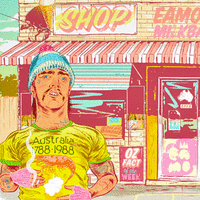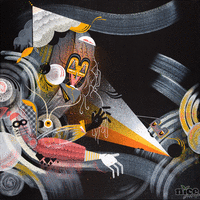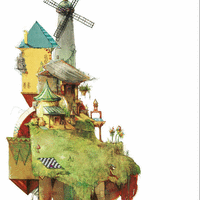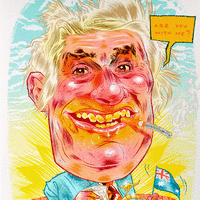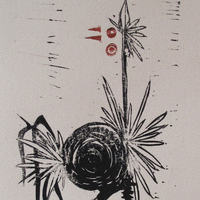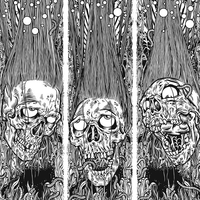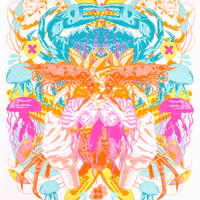With The Swifty Show set to launch at No Vacancy Gallery this Thursday, Penelope Mitchell caught up with Swifty in London to get the details of Swifty’s long and prolific graphic design career as well as the plans for his debut international exhibition.

Heralded as the “Godfather of the Sampling Generation”, Ian Swift, has been an highly prolific figure in the London music and design scenes for over twenty years. Recognized early on by the likes of Erik Spiekermann and Neville Brody as a rising star of typography, Swifty’s unique fonts and bold sampling techniques have extended the boundaries of modern graphic design, whilst his distinctive album sleeve and club flyer designs are responsible for pioneering the UK Acid Jazz movement’s signature style.
Since his debut years at Face Magazine, Swifty has held the role of creative designer for magazines such as Straight No Chaser (The Magazine of World Jazz Jive) and Area, designed covers for countless preeminent musicians through his work with labels Talkin Loud, Mo Wax and Source 360, produced animation for television, designed a camo clothing line, as well as founded his own company Swifty Toypographix through which he has published several books.
In recent years Swifty’s commercial success has enabled him to indulge in more personal projects, pieces that make up the majority of his current touring collection. He  admits that despite his clients remaining pretty liberal with design briefs over the years, he finds something infinitely satisfying in creating entirely independent works. Influenced by childhood nostalgia and drawing from a host of very “British inflated” memorabilia circa 1960, Swifty explores a variety of media such as sculpture, painting and collage in recreating images from of this diverse and turbulent period.
admits that despite his clients remaining pretty liberal with design briefs over the years, he finds something infinitely satisfying in creating entirely independent works. Influenced by childhood nostalgia and drawing from a host of very “British inflated” memorabilia circa 1960, Swifty explores a variety of media such as sculpture, painting and collage in recreating images from of this diverse and turbulent period.
There is no doubt that viewers will derive the same sense of satisfaction from the work, as his eclectic collages, incorporating a plethora of vintage comic books, candy wrappers and other readily consumable printed media, seem to immortalize these otherwise transient images. Through their resurrection and intermingling with prominent pop artist styles, Swifty creates a tangible and everlasting reminder of the “real” generation that was.
Having recently had the privilege to spend a unseasonably sunny afternoon discovering Soho Galleries with this artist, I managed to discover a few more interesting facts, missing pieces to the Swifty puzzle.

Staunchly Independent all the way through…
Ian Swift was born near Liverpool in 1965. The youngest by seven years, Swifty acknowledges that he’d grown accustomed to doing his own thing: ‘I wasn’t really I loner, rather I always sort of had my own agenda.” This became particularly apparent when he first expanded his company, “I found it really hard to delegate. I’m the hands on type: I’d rather just do it myself than attempt to explain what I envisage”. After vacating the rapidly gentrifying Hoxton area in the late 90’s and deciding to downscale, Swifty set up shop at the bottom of his garden- what he now recognizes to be the definitive work station. “It’s kind of isolated, but I like that, I can really zone into my own little world and do my thing.”
The sampling generation…
 The decision to integrate image sampling into his work symbolized a turning point in Swifty’s career, a paradyne that would forever change the face of modern graphic design. Swifty recalls the first time he was confronted with the possibility: “Very early on when I started doing work with Talking Loud, I was approached by a band (Young Disciples) requesting to reproduced a Joe Henderson, Blue Note record sleeve (Mode for Joe).” He recalls that at the time the request was a touchy subject, as although in the 90’s sampled music was most popular and considered rather as homage, Swifty explains that “graphic sampling” “was still frowned upon in a funny kind of way”.
The decision to integrate image sampling into his work symbolized a turning point in Swifty’s career, a paradyne that would forever change the face of modern graphic design. Swifty recalls the first time he was confronted with the possibility: “Very early on when I started doing work with Talking Loud, I was approached by a band (Young Disciples) requesting to reproduced a Joe Henderson, Blue Note record sleeve (Mode for Joe).” He recalls that at the time the request was a touchy subject, as although in the 90’s sampled music was most popular and considered rather as homage, Swifty explains that “graphic sampling” “was still frowned upon in a funny kind of way”.
With the exception of the work of contemporary collagists, such a Peter Blake, the mixture of previously composed images “was still really unknown territory”. However, seeing no harm in the statement the band was trying to make, Swifty agreed to the project and has “never looked back”. Becoming preeminent in this field and establishing prominence in the Acid Jazz scene over the next five years.
Camouflage and other influences…
One of Swifty’s most distinctive themes is the use of Disruptive Pattern Material print (DPM or camouflage) in his work, as seen in his highly popular camo’ clothing line, nostalgia pieces, and Paint by Numbers camouflage designs.
 Swifty admits that aside from its appealing aesthetic value, camouflage subconsciously symbolizes an important influence in his life. “My dad was exempt from going to war, he stayed on the home-front and was an expert in tank and ammunition repairs. I was immersed in this kind of imagery as a kid. Until my older sister encouraged me to persue my drawing talents and go to art school, I had always saw myself
Swifty admits that aside from its appealing aesthetic value, camouflage subconsciously symbolizes an important influence in his life. “My dad was exempt from going to war, he stayed on the home-front and was an expert in tank and ammunition repairs. I was immersed in this kind of imagery as a kid. Until my older sister encouraged me to persue my drawing talents and go to art school, I had always saw myself  joining the army. The war played an important part in the lives of my parents and grandparents, I think it has always had an influence on my work”.
joining the army. The war played an important part in the lives of my parents and grandparents, I think it has always had an influence on my work”.
Aside from the turbulent images of the 60’s and his love of music; another significant influence in Swifty’s work is definitely his love of Pop Art. “When I left school, I remember sitting in art history lessons and always falling asleep”. Something about a cold, dark projection room and monotonous lecturer soullessly pointing at slides of Monet or Turner, turned Swifty else where for inspiration. He found this in the library, where he could again discover things “for him self”. “The first thing I discovered was pop art, I immediately identified with it. Warhol was obviously the king of the scene. Although I was never really into the celebrity thing, there is something about the Campbell’s Soup Can that really appeals to me, it’s typographical, it’s “designed”. The mixing of popular images, with other topical subjects of the time has given Swifty’s work a unique and vibrant dimension.

“Shed life” and the emerging generation…
 A father of three, based at home, Swifty shares his daily routine: “ I generally get up pretty early and get the kids to school. Our youngest, Spike is four, so he needs love. I’m usually in the shed by ten. I paint in the daylight hours and do Mac work at night. At six I’ll knock off and hang with the kids, then go back to work.” Swifty acknowledges that being able to fuse his work and family life has been a very important step in his career, “I ultimately want to move further into fine art, I can do this at home and spend more time with the kids”.
A father of three, based at home, Swifty shares his daily routine: “ I generally get up pretty early and get the kids to school. Our youngest, Spike is four, so he needs love. I’m usually in the shed by ten. I paint in the daylight hours and do Mac work at night. At six I’ll knock off and hang with the kids, then go back to work.” Swifty acknowledges that being able to fuse his work and family life has been a very important step in his career, “I ultimately want to move further into fine art, I can do this at home and spend more time with the kids”.
“I think the kids think that I’m a bit mad. My eldest Jake, who’s thirteen, actually came out with me and help to do the stick ups for my latest project. I don’t think he liked the idea of getting up at five in the morning, but I think he’ll appreciate it in coming years. ” Swifty has enjoyed watching his children develop and is intrigued by the current trends and generally eclectic style of the emerging generation. “Now you’ve got the situation where anything goes. You see kids with vans on, tight jeans, bandannas, bits of mod, ska, skate and whatever. I think to myself: what are you doing? I can look at people and know what they are into, even if they might not know it themselves. It’s really interesting, it’s like we can trace the history and influence behind every pair of trainers”.
“I‘d like to think that some of my quirkiness, will be instilled in my kids,” he explains his goals in raising children “My son is at that stage in life where he is still finding out what drives him, he’s fiddled round with the guitar, etc, but I guess the most important thing that I keep telling him is that you just have to find passion, regardless of what area it’s in…My daughter is also at that transitional period of her childhood. She comes home with celebrity magazines, and it kind of worries me. I have to remind her this is not real life: these people we see so on TV are not real people. I’ve never been into that false thing, I don’t want Facebook, I don’t feel the need to have 5 million friends… “

The future…
 Swifty sees himself moving further into fine arts in the future, “unlike with graphics, with paining you don’t have to please anybody, it’s very personal”. Despite confiding that his ultimate super power would probably be to add more hours to the day, Swifty has never been the anxious type when its comes to producing art:
Swifty sees himself moving further into fine arts in the future, “unlike with graphics, with paining you don’t have to please anybody, it’s very personal”. Despite confiding that his ultimate super power would probably be to add more hours to the day, Swifty has never been the anxious type when its comes to producing art:
“Art has never felt like work to me, it’s not like business where you feel over pressured to achieve. Ever since I’ve worked at home, I’ve felt like my two lives are finally fused. My studio is only forty feet away, so my art is finally infused with every aspect of my life.”
Nowadays, with the amount of pressure that commercial graphic artists operate under, it’s refreshing to find someone who still manages to maintain a totally relaxed vibe. After pointing me in the direction of the nearest tube, Swifty disappeared off into an uninspiring London sunset. He was en route to his favorite hobby store, with one thing on his mind – a fresh pot of khaki paint.
– Penelope Mitchell


















































